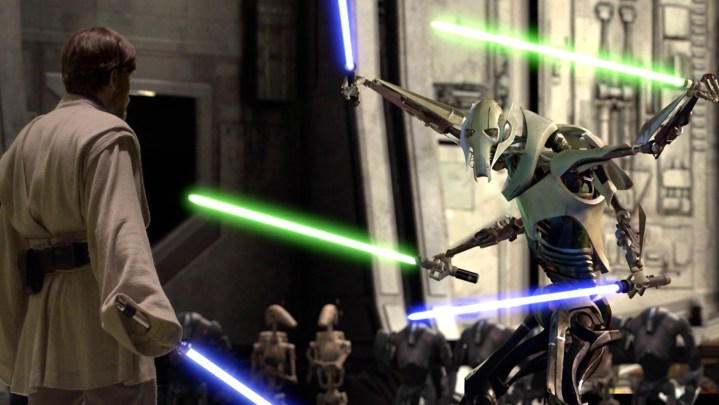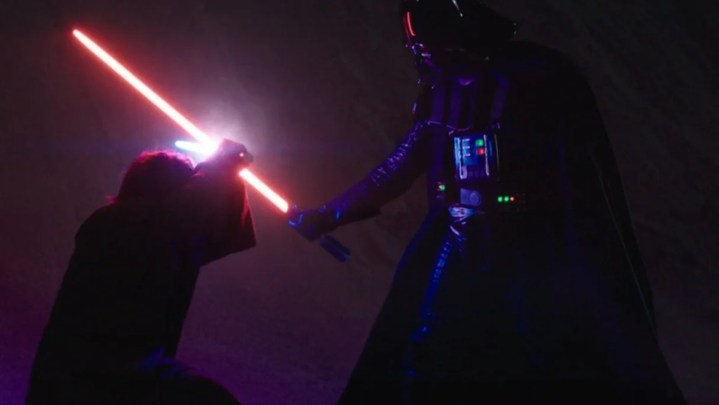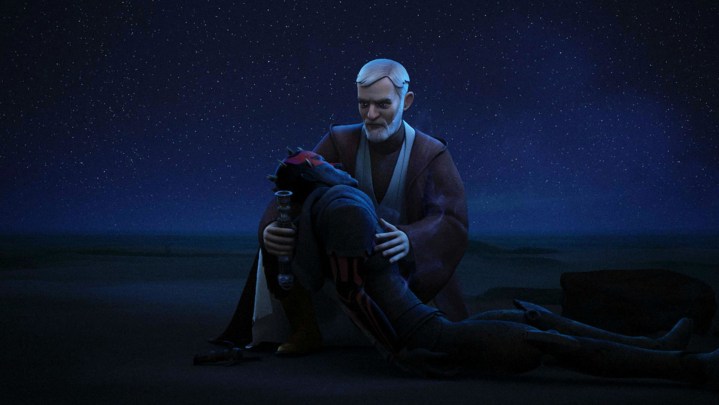Whether it’s Alec Guinness’ sage portrayal in the original trilogy or Ewan McGregor’s modern soulful rendition in the prequel trilogy and Disney+’s Obi-Wan Kenobi, the titular Jedi Master is an undisputed franchise icon. The Star Wars limited series has wrapped by closing on the long-awaited “rematch of the century” longtime fans have been hoping for, but the life that Obi-Wan has led is one filled with memorable moments of triumph — and tragedy.
- The Duel of the Fates in The Phantom Menace
- Defeating the uncivilized General Grievous in Revenge of the Sith
- Battle of the Heroes in Revenge of the Sith
- Rematch against Vader in Obi-Wan Kenobi finale
- Rematch against Vader in A New Hope
- Teaming up with Asajj Ventress against Maul in The Clone Wars
- Putting Maul to rest in Rebels
The movies are understandably where the franchise gets the most attention, but the animated shows and solo series have added worthy points in Kenobi’s life. From his unforgettable first duel against Darth Maul alongside Qui-Gon Jinn to his grand sacrifice against Darth Vader, fans have plenty of Obi-Wan’s greatest hits to savor.
The Duel of the Fates in The Phantom Menace
The Phantom Menace itself may have been a rocky entry in the mainline Star Wars canon, but young Obi-Wan and his Jedi Master Qui-Gon Jinn’s “Duel of the Fates” against Darth Maul will forever be considered timeless. Obi-Wan was but an inexperienced Jedi Padawan at this stage in his life and, like young Anakin Skywalker, was suddenly forced to grow up faster than anticipated.
John Williams’ grandiose track was aptly named and complemented the scene masterfully, as the duel would shape the trajectory of Anakin and the galaxy at large. Say what you will of the prequels’ clunky dialogue and narrative choices, but the lightsaber fights were majestically choreographed and this one was suitably dramatic. Qui-Gon’s death at the hands of the grim Sith Lord deeply resonated, and Obi-Wan rising above the challenge and his whirlwind of emotions to defeat Maul was equally cathartic.
Defeating the uncivilized General Grievous in Revenge of the Sith

Part of what Ewan McGregor’s portrayal of a younger Obi-Wan Kenobi brought to the franchise was that aforementioned composed soulfulness in conjunction with an irresistible dose of wit and sass. Revenge of the Sith managed to stick the landing for the prequel trilogy where The Phantom Menace and Attack of the Clones underwhelmed, and the various moving pieces of the encroaching Empire added to the plot.
One of which was the entertaining and chaotic fight between Obi-Wan and the conniving General Grievous when the latter thinks he finally has the revered Jedi cornered. Even when the deck is stacked against him with a villain that has no sense of honor or dignity, Obi-Wan can still come out on top by beating Grievous at his own game while maintaining a sassy air of class.
Battle of the Heroes in Revenge of the Sith
Another reason that Revenge of the Sith was able to put together a worthy curtain call on this trilogy was fully living up to the “space opera” genre that A New Hope opened with the franchise in 1977. It felt like a fitting Star Wars-themed Shakespearian tragedy, and the epic-scaled “Battle of the Heroes” was the movie’s grand culmination.
Once again, John Williams’ titular track helps complete this scene, with the delightfully over-the-top choreographed lightsaber duel on the magma of Mustafar driving the emotional weight home. This scene brings the best out of both McGregor and Hayden Christensen’s acting chops, with each biting insult Anakin spits at Obi-Wan hurting the audience as much as the Jedi Master himself, and the latter’s desperate pleadings for Skywalker to come back to the light conveying his pain of losing a brother.
Rematch against Vader in Obi-Wan Kenobi finale

Even though it wasn’t the perfect hit that many fans expected, Obi-Wan Kenobi was a respectable and solid entry in the franchise despite some questionable directing and writing choices that finally filled in some highly-demanded gaps in the Jedi Master’s life. Chapter VI of the limited series put to screen one of the most coveted rematches in pop culture media, with an Obi-Wan vs. Darth Vader duel that felt more kinetic than ever. The Jedi even showed off some Extended Universe/Legends-level Force abilities to up the spectacle.
That’s thanks to modern filmmaking advancements in making a Vader suit that’s surely more flexible than what fans have seen in the original trilogy and more stylized action choreography. Obi-Wan Kenobi gave an enticing new look at Darth Vader, as this is arguably the most mentally vulnerable and aggressively unstable we’ve ever seen him. It’s not the same operatic bout as in Revenge of the Sith‘s closing moments, but this fight was a welcome smaller-scale encounter to provide even more emotional context for A New Hope.
Rematch against Vader in A New Hope

Their final duel in A New Hope has, in certain ways, gotten better with time. That’s, of course, due to the likes of Revenge of the Sith, The Clone Wars, and Obi-Wan Kenobi supplementing it with more narrative context. Sure, the scene is understandably more physically restrained given the limitations of sci-fi fantasy filmmaking in the ’70s, but the movie’s overall tone has become part of Star Wars’ charm.
Obi-Wan had been keeping a watchful eye over young Luke Skywalker for some time now, and his death and final words to Darth Vader carry more significance than ever before. He’s done his part, and he knows his time has come. After finally reuniting the Skywalker children and setting Luke on a path to bring peace to the galaxy, he accepts his fate to become one with the Force. Obi-Wan, in a way only a few can, finds the ultimate victory even in defeat.
Teaming up with Asajj Ventress against Maul in The Clone Wars

The idea of bringing Maul back by retconning his supposed death in The Phantom Menace sounded like cheap fan service on paper, but Dave Filoni managed to turn that into one of the most compelling character arcs in all of Star Wars. His acclaimed The Clone Wars animated series further helped provide context for the prequel trilogy, and it made Maul’s boiling quest for vengeance one of them.
The former Sith Lord and his brother Savage Opress capture Obi-Wan to exact his revenge before Count Dooku’s former Dark Side acolyte Asajj Ventress makes a surprise appearance, forming a temporary and unlikely team against Maul and his brother. This was Obi-Wan’s first rematch with Darth Sidious/Palpatine’s former apprentice, and Filoni made full use of the animation medium to deliver the dramatics it calls for.
Putting Maul to rest in Rebels

Coming full circle from his bitter defeat at the hands of Obi-Wan in The Phantom Menace, Maul and the Jedi Master have one final bout to bring the former’s character arc to a close. In Rebels, Maul finally narrows down Obi-Wan’s location on Tatooine — and deduces that he’s here for far more than a self-imposed exile. After that, the Jedi Master would no longer tolerate any other threats, igniting his lightsaber to show that he means to end this chase once and for all.
What ensues is a tense test of lightsaber stances and careful footwork in preparation, but the fight was over in a flash, and Maul is soundly defeated. It wasn’t a dramatic spectacle, and this fight was made all the better for it. There was no way a man consumed by blood-boiling hatred and revenge for what he’s suffered would defeat someone as composed and disciplined as Obi-Wan Kenobi, and the latter still gives Maul a compassionate and peaceful release. “He will avenge us,” Maul’s last words and Obi-Wan laying him to rest show why the Jedi is a shining example of the Order and how to make a sinister villain so satisfyingly grounded, tragic, and sympathetic.
All six episodes of Obi-Wan Kenobi are available to stream now on Disney+.



